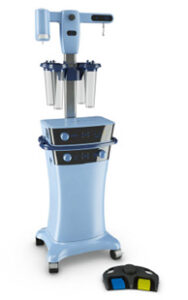Introduction to Technical Aspects about VASER Liposuction
VASER liposuction stands for Vibration Amplification of Sound Energy at Resonance and describes the Gold Standard in today’s available liposuction techniques. Technical aspects about VASER liposuction are unveiled on this blog. HD VASER liposuction utilizes ultrasound energy to gently convert fat clusters that are semisolid into single-cell units that are liquid inconsistency.
This conversion of fat from a semisolid to a liquid state occurs by a process called cavitation which describes how the ultrasound energy can create small air bubbles in the fluid injected before liposuction called a tumescent solution. These air bubbles wedge themselves between fat cells and gently pop them off of each other. Once freed up into single cells and in a liquid form, they can be siphoned off using suction cannulas. There are several advantages to siphoning off fat cells when compared to the traditional liposuction requirement to piece out the semisolid fat clusters:
Technical Aspects about VASER Liposuction Delineated
- First, you can more comprehensively remove fat
- Second, you can more uniformly remove fat
- Third, the fat can now be removed from the superficial compartment of fat that was previously not amenable to fat removal using traditional techniques
- Fourth, it is possible to remove scar laden fat cells that occurs following prior botched liposuction surgeries.
- Finally, the fat that is removed, is more viable than traditional liposuction which has been associated with low 40% fat volume retention following Brazilian Buttock Lift cases at six months
- In contrast, fat cells harvested with VASER technology and appropriately processed have been associated with a 90+ percent take following Brazilian Buttock Lifts.
Uniform and Comprehensive Removal of Fat
VASER liposuction treatments have the advantage of being able to remove fat comprehensively and uniformly. Why is that? It has to do with the fact that VASER liposuction liquefies the fat layers before removal. The fat cells are then siphoned into the cannula with the sweep of the hand called compression coupling.
This is in contrast to the traditional liposuction technique that requires drilling of the fat cells. With traditional liposuction techniques, you are limited to the removal of tunnels of fat due to the configuration of the round shape of suction cannulas. Cross-hatching which describes drilling the fat cells from several separated ports has been advocated as an attempt to allow the removal of fat cells more uniform. However, cross-hatching can only help so much and is no substitute for draining a liquid fat layer.
The analogy I use with my patients is like draining a pool. With one suction you can empty the pool water. First, VASER liposuction allows for the removal of 40% more fat. This allows us to perform Brazilian Butt Lifts in patients who are athletic and thin and who have been denied a BBL on the concern that they may not have enough fat. Finally, fat removal is uniform avoiding any lumps or asymmetries in contour.

Technical Aspects about VASER Liposuction Involving Selective Removal of Superficial Fat
VASER liposuction provides the advantage of fat removal from not only the deep layer but also the superficial layer. This is in contrast to traditional liposuction which has been limited to fat removal from only the deep layer. This is because liposuction cannulas can only penetrate the deep fat layer that is larger and void of connective tissue when compared to the superficial layer.
In contrast, the superficial layer is traversed by infrastructural cables that keep the skin layer attached to the underlying muscles. These infrastructural cables are made of connective tissue and are called retaining cutaneous ligaments. This ligament compartmentalizes the superficial layer of fat and disallows the free movement of liposuction cannulas. It is important to consider that proper liposuction requires the removal of fat uniformly throughout to avoid contour irregularities. This recommendation is even more critical in the superficial layer as it is closer to the surface.
Attempts at non-uniform fat removal in this layer will result in divots. Instead, VASER probes that are narrower than suction cannulas can penetrate the superficial layer and liquify the fat. This superficial layer of fat can then be easily swept into the deep fat layer of fat for removal. Compression coupling describes the use of the non-dominant hand which is used to press and selectively remove the superficial fat.
Selective removal of the superficial fat is what allows for the sculpting of muscle bellies and the creation of highlights demanded by high definition liposuction. This is how we can achieve abdominal etching and the creation of a four-pack for females and a six-pack for males. Ultimately, VASER liposuction allows for an advanced body sculpting technique that allows your surgeon to remove the unwanted fat surrounding your muscles to create a toned, athletic appearance.
Technical Aspects about VASER Liposuction involving Correction of Botched Liposuction Surgeries
There are several reasons for botched liposuction surgery but two common errors include uneven removal of fat from the deep layer of fat and attempted removal of superficial fat using traditional liposuction technique. Since traditional liposuction utilizes hollow cannulas to remove tunnels of fat, attempts at uniform fat removal can fail despite attempts at crosshatching. Furthermore, attempts at removal of superficial fat using cannulas that cannot traverse this layer will surely fail. The consequence of either suboptimal liposuction efforts will be body contouring results that are botched.
Patients with botched liposuction will present demonstrating waviness, asymmetry, and even divots and concavities. More concerning is the deposition of scar tissue around the residual fat cells left behind. Scar tissue gets laid down secondary to the irritation caused by traversing cannulas that irritate the tissue planes. Irritation of tissues results in the arrival of pro-inflammatory cells which then initiate scar tissue formation.
Correction of botched liposuction surgery requires uniform removal of residual fat cells as well as the ability to remove all scar tissue. Amazingly, VASER ultrasound-assisted liposuction provides master surgeons the ability to remove fat cells and scar tissue alike. This capacity of the VASER makes it indispensable for the correction of botched liposuction surgeries.
Optimized Brazilian Buttock Outcomes
By liquifying the fat and requiring gentler siphoning of the fat, VASER assisted liposuction has proven to be significantly more effective in patients desiring fat transfer to the buttock, coined Brazilian buttock lift. Traditional liposuction fat harvesting techniques have been associated with a poor 40% loss in fat cell volume loss at six months. In contrast, VASER liposuction harvesting of fat cells and appropriate processing of fat have been associated with a 90+ % fat graft take. Additionally, since VASER liposuction can harvest 40% more fat than traditional techniques, it offers thinner, more athletic patients the ability to undergo a BBL.
Technical Aspects about VASER liposuction Conclusion
What is VASER liposuction? VASER liposuction is a “Game Changer” in the body contouring and liposuction arena. Today, fat cells can be uniformly and completely removed from the deep fat layer thus creating dramatic results. Also, fat cells can be removed selectively from the superficial layers to provide muscle highlights a necessity of high definition liposuction. High definition liposuction demands true artistry when contouring the body to achieve stunning results with muscle highlights yet in a natural way.
To achieve such results, your surgeon must possess an artistic eye, an intimate knowledge of muscle anatomy, and years of experience using VASER technology. We hope that you found this blog, Technical Aspects about VASER Liposuction helpful when trying to decide on the best liposuction technique for your body contouring needs.

